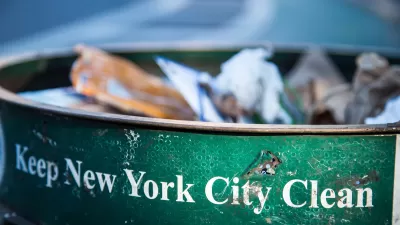SoHo, a Manhattan neighborhood full of luxury apartments and a median income of $111,000/year, must accept a new facility that includes a garage for sanitation trucks. Why, and how will it test the city's commitment to infrastructure design?
A core environmental justice fight has long been the fair distribution of necessary nuisance uses throughout a city. Poor neighborhoods tend to be over-burdened with unpleasant parts of public infrastructure like bus depots and sewage plants, with cumulative negative effects on resident health and quality of life.
Often activists in these over-burdened neighborhoods band together to fight the location of yet another of these kinds of facilities, which leads to inevitable labeling of them as just naysayers and exchanges like, "Well where should they go?" "How about the rich neighborhoods take their share?" "Yeah, like that will happen."
In New York City, former Mayor Bloomberg apparently decided to make it happen, roughly, with a solid waste plan that at least declares that each of the city's five boroughs should take adequate responsibility for its own trash. And current Mayor DeBlasio is sticking with the plan.
This means, as CityLab's Aarian Marshall recently reported, that SoHo, a Manhattan neighborhood full of luxury apartment towers and a median income of $111,000/year, has been forced to accept, despite protest from some very wealthy and powerful people, a large building that includes a garage for sanitation trucks.
FULL STORY: Rich Neighborhood in NYC Actually Gets a “Noxious” Use

Alabama: Trump Terminates Settlements for Black Communities Harmed By Raw Sewage
Trump deemed the landmark civil rights agreement “illegal DEI and environmental justice policy.”

Planetizen Federal Action Tracker
A weekly monitor of how Trump’s orders and actions are impacting planners and planning in America.

The 120 Year Old Tiny Home Villages That Sheltered San Francisco’s Earthquake Refugees
More than a century ago, San Francisco mobilized to house thousands of residents displaced by the 1906 earthquake. Could their strategy offer a model for the present?

In Both Crashes and Crime, Public Transportation is Far Safer than Driving
Contrary to popular assumptions, public transportation has far lower crash and crime rates than automobile travel. For safer communities, improve and encourage transit travel.

Report: Zoning Reforms Should Complement Nashville’s Ambitious Transit Plan
Without reform, restrictive zoning codes will limit the impact of the city’s planned transit expansion and could exclude some of the residents who depend on transit the most.

Judge Orders Release of Frozen IRA, IIJA Funding
The decision is a victory for environmental groups who charged that freezing funds for critical infrastructure and disaster response programs caused “real and irreparable harm” to communities.
Urban Design for Planners 1: Software Tools
This six-course series explores essential urban design concepts using open source software and equips planners with the tools they need to participate fully in the urban design process.
Planning for Universal Design
Learn the tools for implementing Universal Design in planning regulations.
Clanton & Associates, Inc.
Jessamine County Fiscal Court
Institute for Housing and Urban Development Studies (IHS)
City of Grandview
Harvard GSD Executive Education
Toledo-Lucas County Plan Commissions
Salt Lake City
NYU Wagner Graduate School of Public Service





























